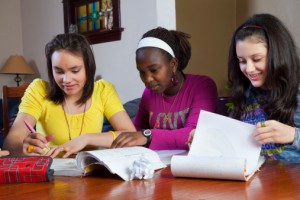 Kids in schools today get tested, evaluated, assessed, analyzed, and then tested some more. In this process, students often end up with a wide range of scores attached to their names, from MEAP scores to NWEA scores to grade level equivalency scores to recommended lexile levels for reading. We may be, as the saying goes, “data rich and information poor.” We have lots of statistics and other data, but we’re not really sure how to use it all. This is particularly true when it comes to reading. I often hear teachers describe their students as readers by assigning grade levels for their reading abilities, as in “she’s in the 9th grade but she reads at the fourth grade level.” This grade level labeling, for lack of a better term, is especially common in our talk about young people who are not meeting the academic expectations placed on them at school. Statements like, “half of my students are reading two grades below level,” are pretty common in my conversations with teachers concerned about their students’ reading skills.
Kids in schools today get tested, evaluated, assessed, analyzed, and then tested some more. In this process, students often end up with a wide range of scores attached to their names, from MEAP scores to NWEA scores to grade level equivalency scores to recommended lexile levels for reading. We may be, as the saying goes, “data rich and information poor.” We have lots of statistics and other data, but we’re not really sure how to use it all. This is particularly true when it comes to reading. I often hear teachers describe their students as readers by assigning grade levels for their reading abilities, as in “she’s in the 9th grade but she reads at the fourth grade level.” This grade level labeling, for lack of a better term, is especially common in our talk about young people who are not meeting the academic expectations placed on them at school. Statements like, “half of my students are reading two grades below level,” are pretty common in my conversations with teachers concerned about their students’ reading skills.
So what did his “fourth grade reading level” score really mean, was it at all useful, and what was getting lost in the process of using this score to describe him as a reader? The fourth grade reading level meant that on one particular day, he answered most of the multiple choice questions right about a text that a testing company like ETS or Pearson decided was something that most fourth graders should be able to read with little difficulty. When presented with questions about more complex texts, he probably began to get lots more questions wrong. That is what his 4th grade level reading score meant.
Don’t get me wrong though – this score does have some use as a general screening tool. A very low score on a generic reading test lets us know that we need to pay attention to how this student reads a wide range of different texts, and it lets us know that he likely needs additional support for reading. It does NOT tell us, however, that he can’t read any text above a fourth grade level, and it does not tell us that he is incapable of thinking deeply about a wide range of texts. It tells us only that he struggled with the texts on this test. This is important to remember because not all texts, and not all reading activities, are the same. Thus, when properly motivated, and when armed with in-depth prior knowledge, this kid can likely read far above his assigned level.
I s this important to know? Of course it is, because if we can find ways to motivate him and build prior knowledge before reading, we can help him move far beyond his test score. However, if we think he can’t read more advanced texts, we might never ask him to him read, or we might just give him low-level texts when we can find them. We might never challenge him to use the resources he already has to become a better reader, and we might allow him to move into learned helplessness and believe that he doesn’t have the potential to read advanced texts well.
s this important to know? Of course it is, because if we can find ways to motivate him and build prior knowledge before reading, we can help him move far beyond his test score. However, if we think he can’t read more advanced texts, we might never ask him to him read, or we might just give him low-level texts when we can find them. We might never challenge him to use the resources he already has to become a better reader, and we might allow him to move into learned helplessness and believe that he doesn’t have the potential to read advanced texts well.
The big picture is that reading is a complex process… there are many factors involved in reading comprehension, and when we reduce a kids’s reading to one single score, we may be missing pieces of their reading puzzle. So what’s the solution? Some initial steps are outlined below:
- Engage kids in conversations about reading and find out what their interests are.
- Learn more about when, where, and what they read. Most kids read more than their teachers might expect, but they don’t always consider it “reading,” especially if they are not reading school books or novels.
- Talk about reading in your classroom and encourage your students to read outside of school for their own purposes.
- In the classroom, rely more on diagnostic and formative assessments to learn about your students as readers.
- Use metacognitive strategies (e.g. Talk the Text), talk moves (e.g. “Tell me more…)” and Visible Thinking routines (e.g. “What makes you say that…”; http://www.visiblethinkingpz.org/) to learn more about how your students think while they read.
- Consider your students to be dynamic, changing readers instead of good or poor readers. Challenge all of them by learning about their strengths and pushing them to get even better, no matter where they are starting. If we believe they can make progress, hopefully they will too!
- If you’re interested in learning more about these issues, the research articles below are great places to start!
Alvermann, D.E. (2001). Reading adolescents‘ reading identities: Looking back to see ahead. Journal of Adult and Adolescent Literacy 44: 676-690.
Dutro, E., Selland, M., & Bien, A (2013). Revealing Writing, Concealing Writers: High- Stakes Assessment in an Urban Elementary Classroom Journal of Literacy Research 45(2):99
Franzak, J. (2006). Zoom: A review of the literature on marginalized adolescent readers, literacy theory, and policy implications. In B. M. Gordon & J. E. King (Eds.), Review of Educational Research (Vol. 76, pp. 209-248). Washington DC: American Educational Research Association.
Moje, E.B., Overby, M., Tysvaer, N., & Morris, K. (2008). The complex world of adolescent literacy: Myths, motivations, and mysteries. Harvard Educational Review 78(1): 107-154.
O‘Brien, D. (2006). ―Struggling adolescents engagement in multimediating: Countering institutional construction of incompetence. In D.E. Alvermann, K.A. Hinchman, D.A. Moore, S.F. Phelps, & D.R. Waff (Eds.), Reconceptualizing the Literacies in Adolescents’ Lives (pp. 147-160). Mahwah, NJ: Erlbaum.
Stockdill, D.& Moje, E. B. (2013). Adolescents as readers of social studies: Examining the relationship between youth’s everyday and social studies literacies and learning. Berkley Review of Education 4(1): 35-68. http://128.48.120.176/uc/item/25348252


 Kids in schools today get tested, evaluated, assessed, analyzed, and then tested some more. In this process, students often end up with a wide range of scores attached to their names, from MEAP scores to NWEA scores to grade level equivalency scores to recommended lexile levels for reading. We may be, as the saying goes, “data rich and information poor.” We have lots of statistics and other data, but we’re not really sure how to use it all. This is particularly true when it comes to reading. I often hear teachers describe their students as readers by assigning grade levels for their reading abilities, as in “she’s in the 9th grade but she reads at the fourth grade level.” This grade level labeling, for lack of a better term, is especially common in our talk about young people who are not meeting the academic expectations placed on them at school. Statements like, “half of my students are reading two grades below level,” are pretty common in my conversations with teachers concerned about their students’ reading skills.
Kids in schools today get tested, evaluated, assessed, analyzed, and then tested some more. In this process, students often end up with a wide range of scores attached to their names, from MEAP scores to NWEA scores to grade level equivalency scores to recommended lexile levels for reading. We may be, as the saying goes, “data rich and information poor.” We have lots of statistics and other data, but we’re not really sure how to use it all. This is particularly true when it comes to reading. I often hear teachers describe their students as readers by assigning grade levels for their reading abilities, as in “she’s in the 9th grade but she reads at the fourth grade level.” This grade level labeling, for lack of a better term, is especially common in our talk about young people who are not meeting the academic expectations placed on them at school. Statements like, “half of my students are reading two grades below level,” are pretty common in my conversations with teachers concerned about their students’ reading skills. s this important to know? Of course it is, because if we can find ways to motivate him and build prior knowledge before reading, we can help him move far beyond his test score. However, if we think he can’t read more advanced texts, we might never ask him to him read, or we might just give him low-level texts when we can find them. We might never challenge him to use the resources he already has to become a better reader, and we might allow him to move into learned helplessness and believe that he doesn’t have the potential to read advanced texts well.
s this important to know? Of course it is, because if we can find ways to motivate him and build prior knowledge before reading, we can help him move far beyond his test score. However, if we think he can’t read more advanced texts, we might never ask him to him read, or we might just give him low-level texts when we can find them. We might never challenge him to use the resources he already has to become a better reader, and we might allow him to move into learned helplessness and believe that he doesn’t have the potential to read advanced texts well.